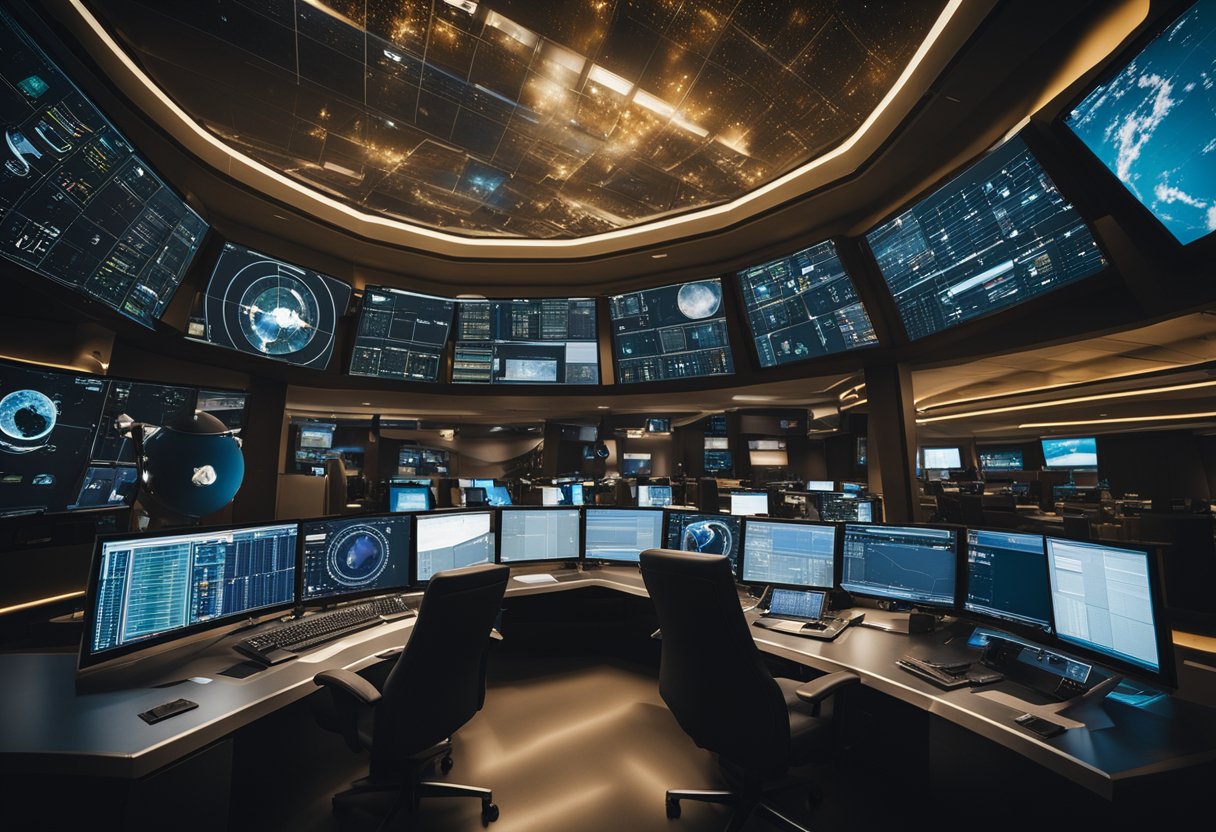
Space Debris Management – Space debris, also referred to as space junk, is a collection of defunct human-made objects in Earth’s orbit. These objects include non-operational spacecraft, abandoned launch vehicle stages, mission-related debris, and fragments resulting from spacecraft disintegration. Space debris presents an escalating environmental issue as the accumulation in the orbital regions can lead to collisions with operational spacecraft, potentially disrupting critical services such as weather forecasting, telecommunications, and global positioning systems.
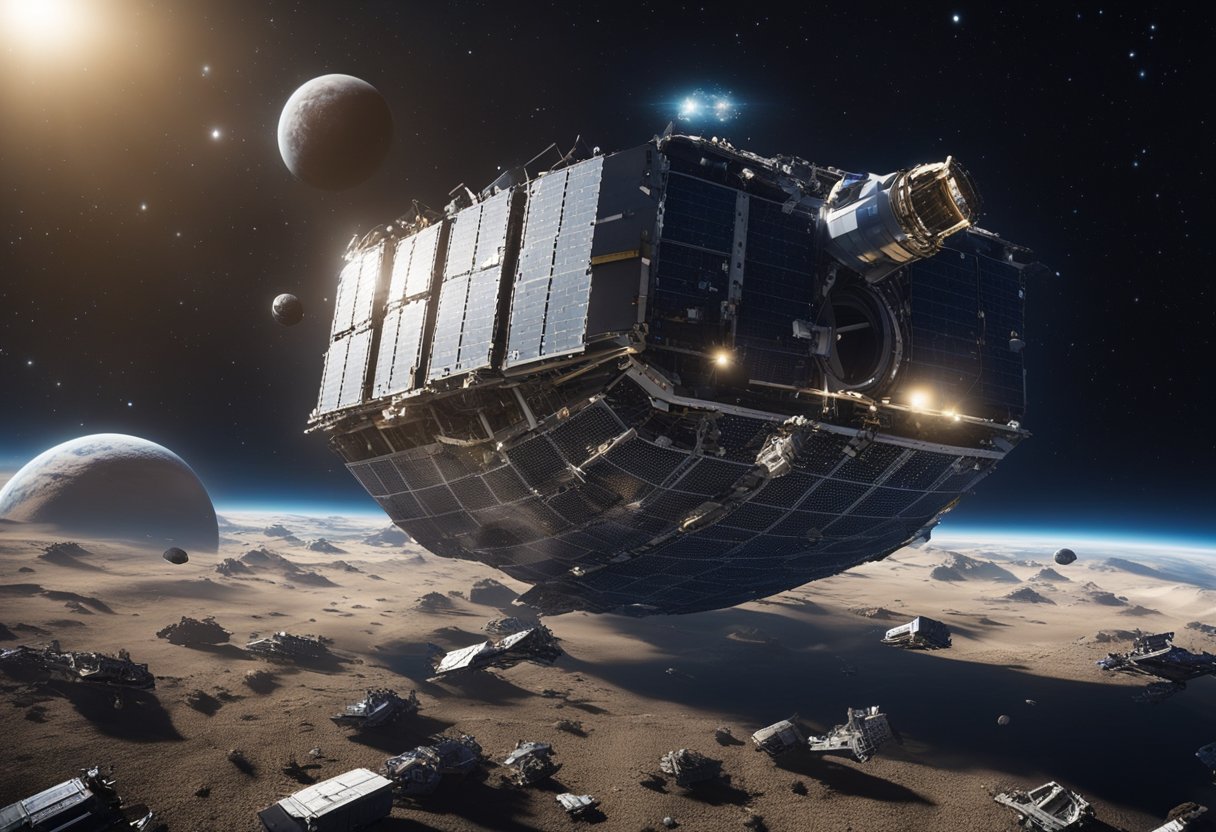
Addressing space debris is a multi-faceted challenge involving various strategies. Mitigation guidelines have been established to minimise the creation of new debris, such as the guidelines by the Inter-Agency Space Debris Coordination Committee. Orbit management and space traffic control are being continuously developed, as they are crucial in preventing potential collisions. Moreover, actively removing debris and avoiding collisions through conjunction analysis are vital to maintaining a sustainable space environment. Legislation and governance play pivotal roles in orchestrating a collaborative global effort to tackle the space debris problem.
With the increasing clutter surrounding our planet, space debris represents a compelling issue for space traffic and the integrity of our satellites. We’ll explore both what composes this debris and the risks it poses to present and future space operations.
Space debris encompasses a range of materials. These often include defunct rocket stages, aged satellites, and fragments generated from collisions. To provide an ordered perspective:
Understanding these categories helps us strategize for mitigation and cleanup.
Our satellites face significant collision risk from these debris elements. Fragments smaller than 1 cm can damage or disrupt spacecraft systems, while those ranging from 1 to 10 cm can incapacitate a satellite or penetrate shields. Larger fragments can cause catastrophic break-ups, resulting in even more debris.
At SpaceVoyageVentures.com, we monitor these concerns closely. As a company invested in the future of space tourism, we recognise our responsibility to preserve the integrity of low-earth orbit and ensure safety for all travellers venturing beyond our atmosphere.
As leaders in the development and promotion of sustainable space practices, we understand the critical importance of controlling space debris to ensure the long-term usability of outer space. Our goal is to discuss and promote adherence to international guidelines and to foster collaborative efforts for debris mitigation.
Working closely with global entities such as the Inter-Agency Space Debris Coordination Committee (IADC), we actively participate in the formulation and dissemination of strategies to address the issue of debris in space. It is imperative that nations and companies comply with space debris mitigation guidelines to preserve the space environment. Our commitment extends to fostering consensus on norms that significantly reduce the risk posed by orbital debris.
Our efforts are tailored to integrate comprehensive debris mitigation measures into the design and operation of space systems. Specific measures include:
A list of best practices is available through the United Nations Office for Outer Space Affairs, with which we confirm our alignment. These practices are intended to safeguard both current and future space endeavours, in line with evolving space debris mitigation standards. Compliance with these guidelines is not just about adherence to rules—it reflects our responsibility towards preserving space for future generations.
For entities like SpaceVoyageVentures.com, which represents the burgeoning field of space tourism, these guidelines are particularly pertinent. Tourist spaceflights must integrate debris mitigation into their operational framework to protect the interests of both clients and the space environment at large.
We understand that responsible orbit management and space traffic control are essential to maintain the sustainability of space as a resource. Our focus encompasses regulatory frameworks, coordination among satellite operators, and continuous surveillance to ensure the orderly use of space.
Orbital slots are a finite resource, and their allocation is a critical component of space traffic management (STM). In geostationary orbit (GEO), slots are particularly prized due to their fixed position relative to the Earth’s surface, making them ideal for communications satellites. It’s our responsibility to contribute to the international effort to allocate these slots fairly and efficiently, ensuring that satellite operators have equitable access and that their assets are spaced to avoid interference and potential collisions.
For space surveillance network (SSN) operations, the tracking of objects in low-earth orbit (LEO) and beyond is imperative. Our systems employ an array of ground-based radars and telescopes to monitor thousands of pieces of space debris and active satellites. Tracking accuracy is of utmost importance, as even minute miscalculations can lead to catastrophic collisions. Our surveillance data facilitates the sharing of conjunction assessments with satellite operators, enabling course corrections and evasive manoeuvres to prevent accidents and ensure the seamless functioning of STM systems.
The intricate dance of satellites and debris in Earth’s orbits requires meticulous observation and management, and we are at the forefront of safeguarding this celestial thoroughfare for current and future generations.
Active Debris Removal (ADR) comprises targeted efforts to eliminate existing space debris that threaten our orbital environment. These strategies are crucial to sustaining space operations by reducing potential collisions in space.
We are witnessing significant advancements in ADR technology. Organisations are focusing on net capture, robotic arms, and harpooning techniques—an array of solutions tailored to the varied types of debris in orbit. For instance, the European Space Agency’s ClearSpace-1 mission is pioneering with its use of robotic arms to capture a Vespa payload adapter. It showcases how multifaceted ADR technology development needs to be for operational success.
Our current leaders in ADR comprise governmental and commercial entities that recognise the urgency of debris mitigation. The White House recently released a NATIONAL ORBITAL DEBRIS IMPLEMENTATION PLAN, which emphasises Active Debris Removal as part of a broader National Space Traffic Management strategy. Similarly, companies like ClearSpace are collaborating with space agencies to conduct ADR missions that validate these emergent technologies. These coordinated efforts reflect our shared responsibility in securing the space domain for future endeavours, such as those anticipated by pioneers like SpaceVoyageVentures.com.
In the realm of space operations, our continuous monitoring and timely responses are critical to mitigate the risks of collisions. We focus on two pivotal components: understanding and acting on conjunction data messages and executing manoeuvres to prevent collisions.
When spacecraft or debris come dangerously close to each other, a conjunction data message (CDM) is issued. A CDM contains vital information, such as the time of closest approach, relative positions and velocities, and the probability of collision. Our task is to accurately interpret these messages for effective risk assessment. By doing so, we ensure the sustainability of space operations and safeguard our assets.
If a potential collision is identified, we may need to conduct a collision avoidance manoeuvre. This complex process involves calculating the precise thrust and timing needed to alter a spacecraft’s orbit. The primary goals are to significantly reduce the probability of collision and to maintain the operational lifespan of the spacecraft. Manoeuvres are carefully analysed to balance the immediate risk against the long-term implications of using limited onboard fuel.
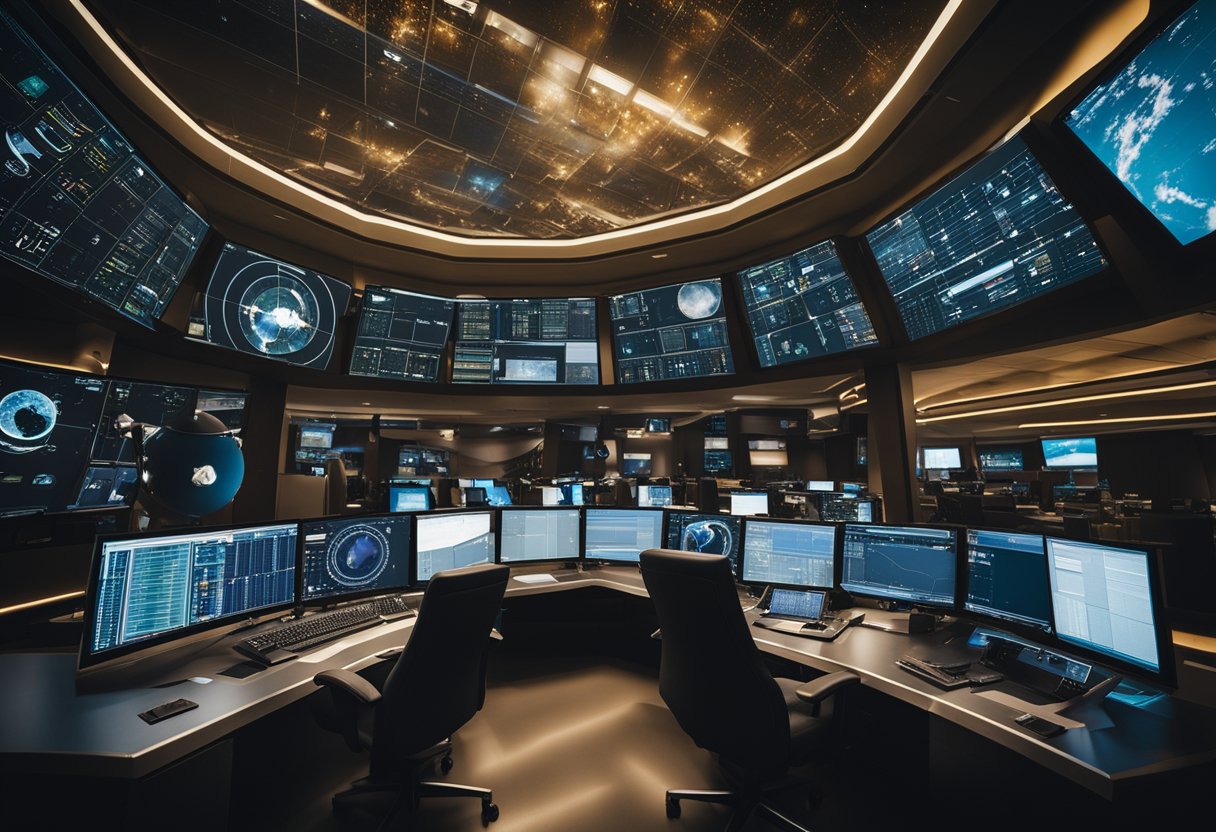
We observe that the advent of commercial space ventures and increased satellite launches have necessitated stringent legislation and governance to address space debris management. Ensuring sustainable space operations requires the collective effort of both national governments and international bodies to create and enforce laws and guidelines.
United States: The U.S. government has taken strides in mitigating space debris through Federal Communications Commission (FCC) regulation. These regulations are pivotal in governing the activities of commercial space companies, ensuring they adhere to debris mitigation standards. Moreover, the recent establishment of a new FCC bureau underscores America’s commitment to addressing the space debris problem.
European: European nations collectively adhere to regulations enforced by the European Space Agency (ESA), which has set guidelines to mitigate space debris. Individual member states also carry national laws that work harmoniously with ESA’s overarching guidelines.
The Outer Space Treaty serves as the fundamental international legal framework for space activities, establishing space as a domain benefiting all humanity and constraining both military uses and the management of space debris. However, enforcement remains a challenge, reflected in ongoing discussions about how current national regulations align with the treaty’s stipulations.
International Guidelines: We recognise the importance of international cooperation in governing space activities. To this end, entities like the United Nations Committee on the Peaceful Uses of Outer Space (COPUOS) have developed voluntary international guidelines to ensure long-term space sustainability. These guidelines have been instrumental in setting a standard for spacefaring nations and companies, guiding them to adopt practices that prevent further debris generation.
We understand that maintaining the delicate balance between advancing space exploration and preserving the outer space environment for future generations is intricate and requires constant vigilance and adaptation.
When a spacecraft completes its mission, ensuring a safe and sustainable end-of-life strategy is crucial for the long-term preservation of low-Earth orbit. We focus on two main strategies: controlled reentry procedures when feasible, and designing the satellite for demise if uncontrolled reentry is inevitable.
In the context of space debris management, it is imperative for us to establish reliable reentry procedures. One approach is the utilisation of disposal orbits – often referred to as graveyard orbits – which are specifically designated to safely contain out-of-service satellites. Alternatively, a controlled atmospheric reentry is applied to ensure the space hardware descends and burns up in the Earth’s atmosphere, minimising potential harm to populated areas. For example, the International Space Station (ISS) employs precise reentry corridors over uninhabited regions such as oceans.
When controlled reentry isn’t a suitable option, satellites and their payloads are designed with the end-of-life in mind, a concept known as ‘Design for Demise’ or DfD. The objective here is to ensure that, should the spacecraft enter the Earth’s atmosphere uncontrolled, its construction materials and design facilitate complete disintegration before reaching the ground. This strategy significantly reduces the risk of debris surviving the reentry and potentially causing harm or damage.
By incorporating these end-of-life strategies, we make certain that the legacy of our space missions does not include adding to the already critical issue of space debris, thereby safeguarding the orbital paths for future endeavours, such as those envisaged by SpaceVoyageVentures.com.
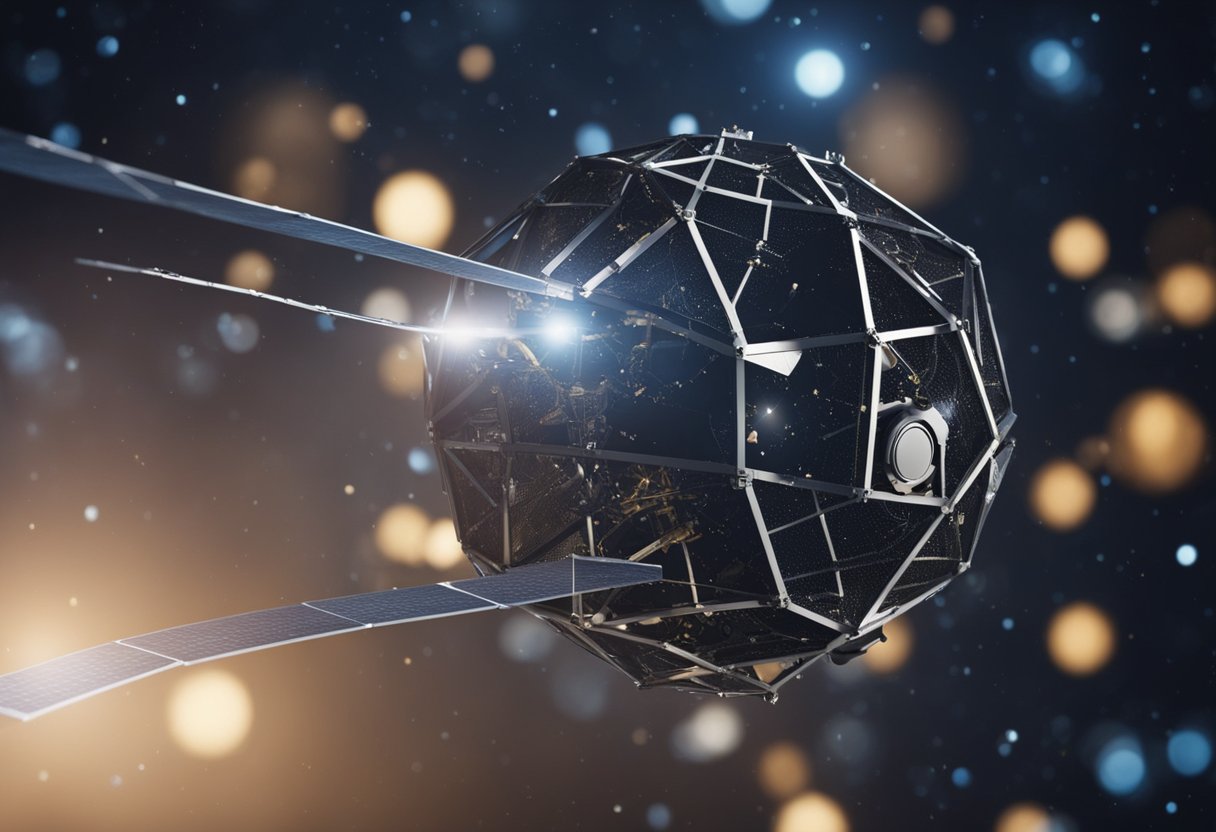
In addressing the complexities of orbital debris, we recognise that innovation and attention to long-term sustainability are critical. Our future in space depends on these efforts, ensuring the safe and profitable continuation of space missions.
Researchers are now focusing on technologies that manage and reduce space debris. While traditional methods have been geared towards tracking and avoiding debris, the aerospace community is launching initiatives to actively remove debris from orbit. Notably, The Aerospace Corporation is involved in estimating the amount of debris generated in collisions and assists with reentry predictions. Methods such as robotic arms, nets, and harpoons are being tested for their efficiency and cost-effectiveness in capturing and retiring debris to safe orbits or guiding them to a controlled reentry. These innovative solutions promise to enhance the long-term sustainability of space activities by mitigating the risks posed by debris collisions.
Our sustainable use of space hinges on the implementation of comprehensive debris management strategies. Establishing guidelines for the end-of-life disposal of satellites and rocket stages has become a core principle, essentially serving as a measure of return on investment (ROI) for future missions. For instance, NASA’s historical commitment to orbital debris mitigation has set a precedent for responsible space behaviours. The long-term sustainability of space activities also complements commercial ventures such as SpaceVoyageVentures.com, which document and advocate for sustainable and safe space tourism opportunities. Looking ahead, we must ensure that our venture into the cosmos remains profitable without compromising the irreplaceable ecosystem beyond our atmosphere.
In our endeavours to address the issue of space debris, we recognise the importance of educating the public and stakeholders. Raising awareness and incorporating diverse perspectives are critical to developing sustainable solutions.
We prioritise the execution of targeted outreach programmes and campaigns to increase public awareness about the dangers of space debris. Our strategic approach includes:
By promoting a clear understanding of space debris, we foster a community invested in the future of space exploration and sustainability.
The inclusion of stakeholder input is pivotal for devising effective strategies for space debris mitigation. Our approach involves:
We are committed to integrating the practical insights and innovative ideas from a broad array of perspectives to shape policies that effectively manage space debris.
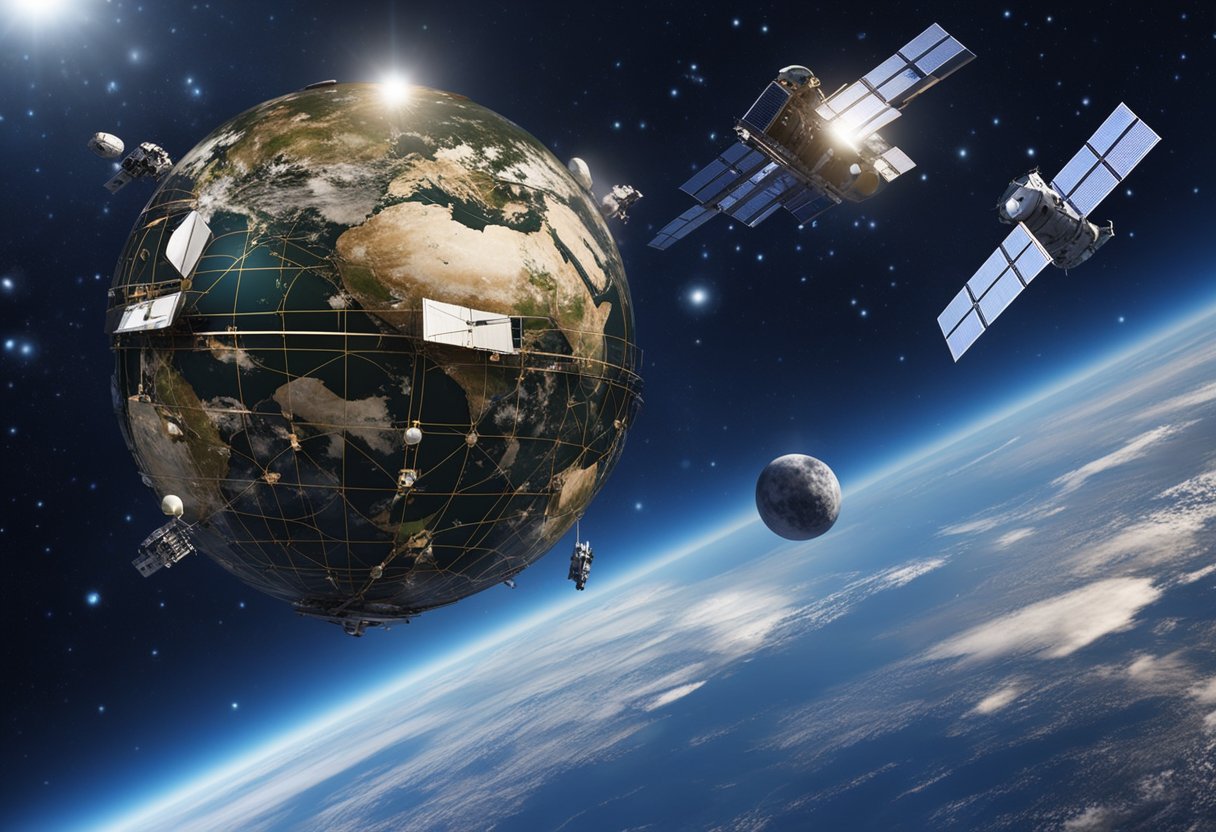
Space debris increasingly jeopardises critical services that rely on satellite technology, from earth observation to GPS and telecommunications.
Space debris poses a significant risk to satellites that provide vital Earth observation data. These satellites monitor climate change, track natural disasters, and support agricultural planning. A collision with space debris could disrupt our ability to collect this crucial information, impacting disaster relief and climate monitoring efforts. Similarly, the Global Positioning System (GPS) relies on a constellation of satellites orbiting Earth. Space debris compromises the integrity of these orbits, threatening navigation services that are essential for aviation, maritime, and road transport.
The sphere of telecommunications is equally at risk. Communication satellites enable global broadcasting, internet, and mobile phone services. Increasing space debris can lead to the loss of these satellites, leading to significant economic consequences and a potential breakdown in global communications. Moreover, debris has the potential to endanger the International Space Station (ISS), which is not only a hub for scientific research but also serves as a symbol of international cooperation in space.
While we explore opportunities for space tourism through platforms such as SpaceVoyageVentures.com, which documents the burgeoning field of space travel, the mitigation of space debris remains crucial to preserving the space environment for these future endeavours. Our reliance on satellites for global services underscores the need for robust space debris management to protect these assets and ensure the continuity of services that have become indispensable in our daily lives.
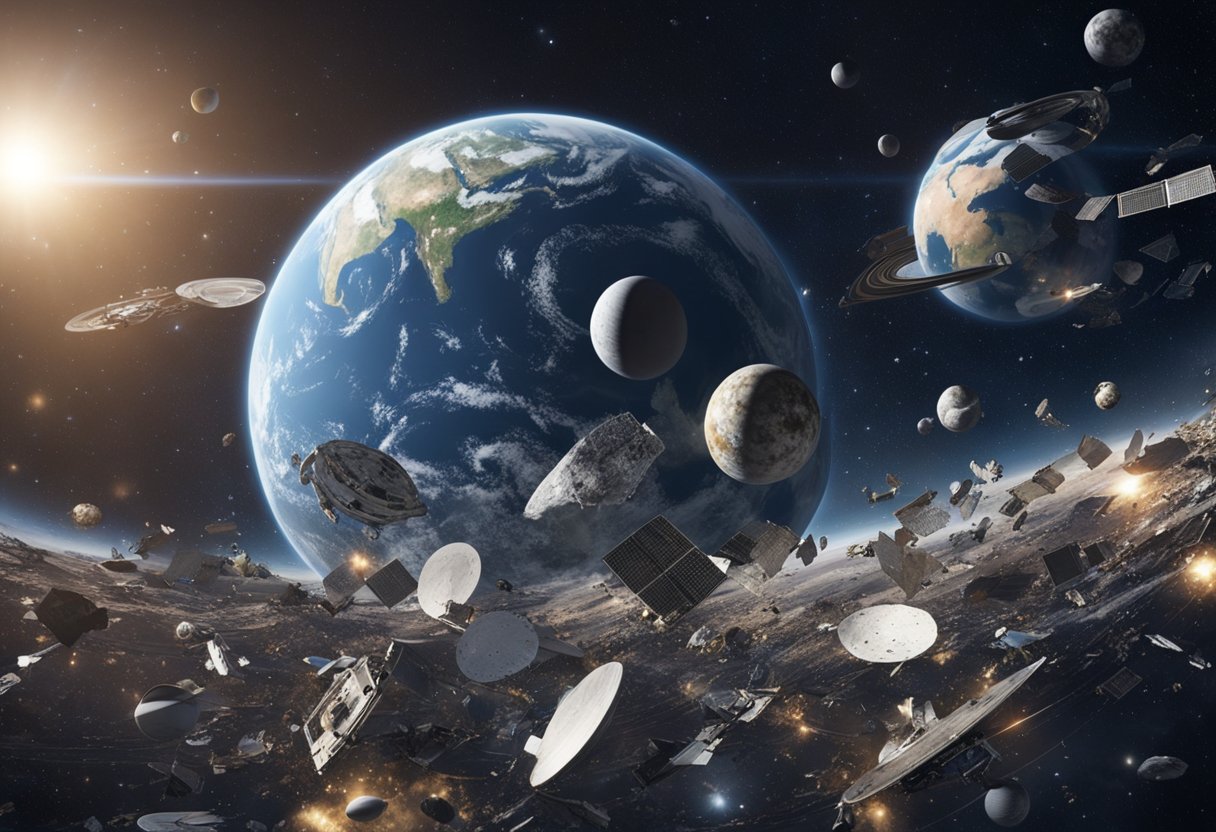
We’ll address key queries surrounding the efforts to clear space debris, with specifics on current remediation projects, leading companies, employed techniques, job prospects, NASA’s strategies, and the risks associated with different types of debris.
Current initiatives focus on actively removing space debris from orbit. These projects involve capturing debris with nets, harpoons, or robotic arms and then bringing them down to burn up in the Earth’s atmosphere.
Companies like Astroscale are at the forefront, developing technology specifically designed to locate, secure, and dispose of space debris. They’re spearheading the advancement of in-orbit services to ensure long-term space sustainability.
To mitigate risks, several techniques, such as collision avoidance manoeuvres, passivation of spent rocket stages, and the design of spacecraft to withstand impacts, are employed. There is also a push for more robust tracking systems to monitor debris movement.
Job prospects in this sector range from aerospace engineering to space law and policy advocacy. Many institutions are seeking experts that can develop innovative technologies to track, analyse, and mitigate debris.
NASA has established comprehensive orbital debris mitigation guidelines and is actively pursuing mitigation efforts, which include minimising the release of debris, post-mission disposal, and preventing on-orbit break-ups.
The primary categories include defunct satellites, spent rocket stages, and fragmentation debris. These objects pose collision risks to operational spacecraft and can lead to the Kessler Syndrome, where cascading collisions generate more debris, thus increasing the likelihood of further impacts.